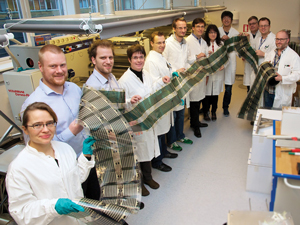Green Energy
 In an impressive feat of engineering, scientists in Denmark have devised a rapid, scalable and industrially viable way to manufacture large sheets of flexible organic tandem solar cells. Their successful application of roll-to-roll processing is a significant achievement for this emerging renewable technology.
In an impressive feat of engineering, scientists in Denmark have devised a rapid, scalable and industrially viable way to manufacture large sheets of flexible organic tandem solar cells. Their successful application of roll-to-roll processing is a significant achievement for this emerging renewable technology.

- How Do Solar Cells Work?
Solar cell is an electrical device which converts the light energy directly into electricity utilizing photovoltaic effect. It is also defined as the form of photoelectric cell having electrical characteristics like current, voltage and resistance. There...
- Xunlight Partners With Trina Solar On Pv System
Toledo, Ohio United States Xunlight Corporation, a manufacturer of flexible and lightweight thin-film silicon solar modules has completed a 220 KW demonstration project utilizing its flexible solar panels, in partnership with Trina Solar. In this project,...
- Organic Solar Cells
Heliatek GmbH announced a record breaking 12% cell efficiency for its organic solar cells, establishing a world record. In cooperation with the University of Ulm and TU Dresden, the solar cells were measured by the accredited testing facility SGS. The...
- Thin Film Solar Cells: New World Record For Solar Cell Efficiency
Article published on www.sciencedaily.com Jan. 18, 2013 — In a remarkable feat, scientists at Empa, the Swiss Federal Laboratories for Materials Science and Technology, have developed thin film solar cells on flexible polymer foils...
- Scientists Build The First All-carbon Solar Cell
article published in www.sciencedaily.com, October 31st 2012 Stanford University scientists have built the first solar cell made entirely of carbon, a promising alternative to the expensive materials used in photovoltaic devices today.The results...
Green Energy
Organic solar cells reach manufacturing milestone

An organic photovoltaic (OPV) solar cell is a polymer-based thin film solar cell. OPV solar cells have been the focus of much research as they are lightweight, flexible, inexpensive, highly tuneable and potentially disposable. They are also unparalleled in the number of times that they can pay back the energy used in their manufacture.
In the quest to improve the efficiency of OPVs, which, in addition to operational lifetime, is currently their key limitation, various new materials, processing methods and device architectures have been investigated. Among these is the tandem cell, where multiple junctions are stacked upon one another. This can increase the efficiency of the cell by not only increasing the number of junctions, but, along with careful selection of complimentary materials, can make it possible to harvest photons from a broader region of the spectrum. However, this more complicated architecture renders their manufacture significantly more challenging.
Frederik Krebs and his research team at the Technical University of Denmark are specialists in renewable energy technologies, particularly OPVs. For the first time they have demonstrated the successful roll-to-roll manufacture of tandem OPV modules, each comprised of a stack of 14 discrete layers, which are rapidly printed, coated or deposited one on top of another by a machine reminiscent of a printing press. The experiment was carried out in simple conditions and is extremely fast, with a single solar cell module being printed onto blank foil each second. Most importantly, the process is relatively cheap and completely scalable, with a high technical yield.

‘If I have made a kilometre of solar cells, then I am not interested if one module has an efficiency of 10% and the rest are 2% – I think what is important is what you can make for the public,’ says Krebs. ‘I am the guy that makes a lot of it and tries to look for the average and what is practical, and then there are the other guys that look at what is obtainable. Everybody has their role to play and hopefully we will meet some day, probably somewhere in the middle.’
‘The performance from these scalably fabricated devices has a long way to go to achieve commercial viability,’ states Seth Darling, an expert in solar energy conversion at Argonne National Laboratory, US, ‘but this work clearly shows that the process itself is feasible and has the potential for genuine market impact.’
The future direction of this research now lies in materials development, and in the optimisation of each layer for the manufacturing process.
http://www.rsc.org/chemistryworld/2014/06/roll-roll-flexible-organic-tandem-solar-cells
- How Do Solar Cells Work?
Solar cell is an electrical device which converts the light energy directly into electricity utilizing photovoltaic effect. It is also defined as the form of photoelectric cell having electrical characteristics like current, voltage and resistance. There...
- Xunlight Partners With Trina Solar On Pv System
Toledo, Ohio United States Xunlight Corporation, a manufacturer of flexible and lightweight thin-film silicon solar modules has completed a 220 KW demonstration project utilizing its flexible solar panels, in partnership with Trina Solar. In this project,...
- Organic Solar Cells
Heliatek GmbH announced a record breaking 12% cell efficiency for its organic solar cells, establishing a world record. In cooperation with the University of Ulm and TU Dresden, the solar cells were measured by the accredited testing facility SGS. The...
- Thin Film Solar Cells: New World Record For Solar Cell Efficiency
Article published on www.sciencedaily.com Jan. 18, 2013 — In a remarkable feat, scientists at Empa, the Swiss Federal Laboratories for Materials Science and Technology, have developed thin film solar cells on flexible polymer foils...
- Scientists Build The First All-carbon Solar Cell
article published in www.sciencedaily.com, October 31st 2012 Stanford University scientists have built the first solar cell made entirely of carbon, a promising alternative to the expensive materials used in photovoltaic devices today.The results...
